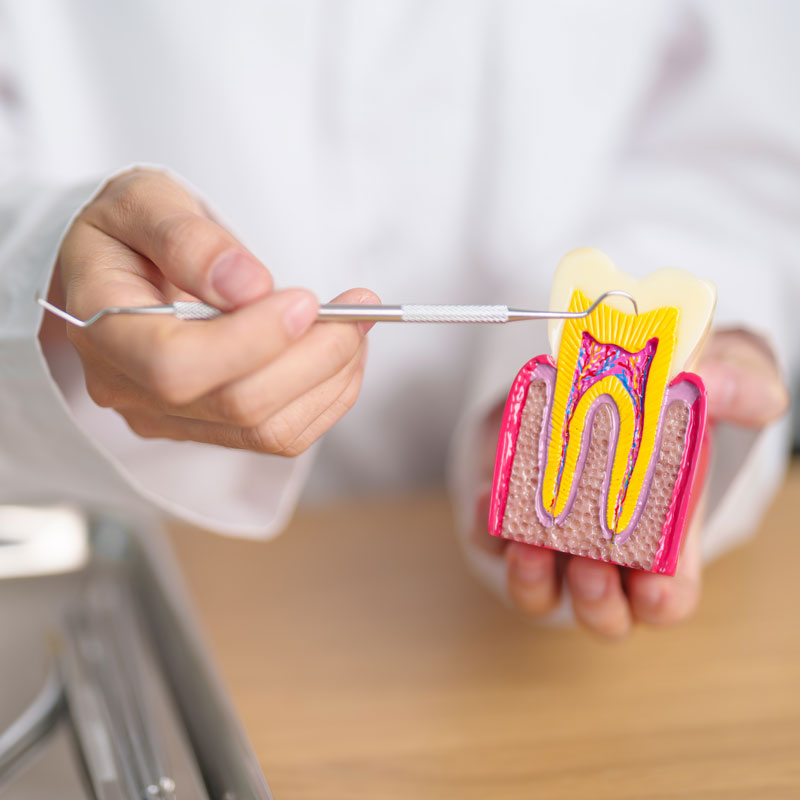When people hear about root canals, many envision intense pain and discomfort. However, thanks to modern dentistry, the root canal procedure has evolved into a routine treatment designed to relieve pain and save teeth, not cause it. In this guide, we’ll explore the purpose of a root canal, break down the process step-by-step, debunk common myths, and address the realities of pain management and recovery.
1. Understanding the Purpose of a Root Canal
A root canal becomes necessary when the soft tissue inside your tooth, known as the pulp, becomes infected or inflamed. The pulp contains nerves, blood vessels, and connective tissue, playing a crucial role during a tooth’s development. However, once the tooth is fully formed, it can survive without the pulp because it gets nourishment from surrounding tissues.
Here are some common reasons for a root canal:
- Deep decay: Untreated cavities can allow bacteria to enter the tooth, leading to infection.
- Cracks or fractures: Trauma to the tooth can damage the pulp, causing inflammation or infection.
- Repeated dental procedures: Multiple procedures on a single tooth can stress the pulp.
- Abscess: An untreated infection can form a pus-filled pocket at the root of the tooth.
By performing a root canal, dentists can remove the infected pulp, clean the inside of the tooth, and seal it, preventing further infection and saving the tooth from extraction.
2. Step-by-Step Guide to the Root Canal Procedure
Knowing what to expect can significantly reduce any anxiety surrounding the root canal procedure. Here is a brief overview of each step:
- Initial Examination and X-rays: The dentist examines the tooth and takes X-rays to assess the extent of the infection or damage. This helps create a clear treatment plan.
- Anesthesia: Local anesthesia is administered to numb the area around the affected tooth. This ensures that you remain comfortable and pain-free throughout the procedure.
- Accessing the Pulp: A small opening is made in the crown of the tooth to access the infected pulp. This is done carefully, ensuring minimal damage to the surrounding tooth structure.
- Cleaning the Root Canals: The infected or damaged pulp is removed using specialized tools. The root canals are then cleaned, disinfected, and shaped to prepare for the filling.
- Filling the Canals: After cleaning, the canals are filled with a rubber-like material called gutta-percha. This seals the canals, preventing bacteria from re-entering.
- Sealing the Tooth: The opening in the tooth is sealed with a temporary filling. In most cases, a permanent crown will be placed later to protect the tooth and restore full function.

3. Common Myths About Root Canals
There are many myths surrounding root canals, which can create unnecessary fear. Let’s address a few common misconceptions:
- Myth 1: Root canals are extremely painful.
- Fact: The root canal procedure is designed to relieve the pain caused by infection. With modern anesthesia, most patients feel little to no discomfort during the procedure.
- Myth 2: It’s better to extract the tooth.
- Fact: Keeping your natural tooth is always the best option. Root canals allow you to save the tooth, whereas extraction can lead to issues such as shifting teeth, bone loss, and the need for more expensive treatments like implants or bridges.
- Myth 3: Root canals cause illness.
- Fact: This outdated theory has been thoroughly debunked by scientific research. Root canal treatments are safe and effective at eliminating infection and preventing further oral health issues.
4. The Role of Anesthesia in Pain Management
One of the biggest concerns patients have about root canals is the pain. However, the use of local anesthesia makes the procedure virtually painless. Here’s how anesthesia helps:
- Numbing the Area: Local anesthesia is injected around the affected tooth to numb the surrounding tissue, ensuring that you don’t feel pain during the procedure.
- Post-Anesthesia Sensation: The numbness from the anesthesia may last for a few hours after the procedure, so it’s essential to avoid chewing on the affected side until the numbness wears off.
- Pain-Free Procedure: Thanks to anesthesia, most patients report that root canals are no more painful than getting a routine filling.
If you experience anxiety about dental procedures, talk to your dentist about sedation options, which can help you feel more relaxed during treatment.
5. Post-Procedure Discomfort: What’s Normal?
While the root canal itself is typically painless, it’s common to experience some mild discomfort after the procedure. This is a normal part of the healing process, and the symptoms usually subside within a few days.
Here’s what you might experience after a root canal:
- Mild soreness: The area around the tooth may feel sore for a few days. Over-the-counter pain medications like ibuprofen can help manage this.
- Sensitivity: The treated tooth may be sensitive to hot or cold for a short time after the procedure. This sensitivity should decrease as the tooth heals.
- Gum tenderness: Some patients experience slight swelling or tenderness in the gums around the treated tooth.
Managing Discomfort:
- Take pain relievers as recommended by your dentist.
- Avoid chewing on the treated tooth until a permanent crown is placed.
- Use cold compresses to reduce swelling or discomfort.
If your pain worsens or doesn’t subside after a few days, it’s essential to contact your dentist, as this could indicate a complication, such as infection or the need for further treatment.
Root canals are often misunderstood, but they play a vital role in saving teeth and eliminating the pain caused by infection. Thanks to modern dental techniques and effective pain management, the root canal procedure is far less daunting than it once was. By understanding what to expect before, during, and after a root canal, you can feel more confident in your dental care decisions and focus on preserving your smile.
If you have any concerns about root canal procedures, speak with your dentist, who can provide personalized advice and guidance to ensure a comfortable and successful treatment experience.









